VIDEO: Ariel Wickham and Full Circle Cycling
Ariel Wickham is an accomplished product designer (Burton, The North Face, Machines for Freedom, and now on her way to Specialized!), a badass road/gravel/MTB cyclist, and a stellar human being.
Her latest project, Full Circle Cycling, pulls together the cycling community to support acknowledgement and awareness of tribal people (like the Coast Miwok in Marin) and the history of the land we use for recreation everyday. We wanted to find out a bit more about the drive behind the project and share her thoughtful responses.
Tell us a little about your design background. When did you first start illustrating? Does design allow you to express something that you can’t through any other medium?
I think I've always been drawing, but mostly because I was obsessed with animals, and always an observer type. My parent's saw this in me and bought me a book before I was 5 that had step by step instructions on how to draw animals by first drawing shapes to create volumes. Learning how to do that really helped teach my brain the basics of drawing and how to break objects down. They also put me in drawing and art classes but I would often get in trouble because the teachers just wanted you to copy what they were making, or always create photo realistic pieces, and I'd always deviate from the lesson to create something slightly different. A lot of that I think came from my parent's also teaching me that all beings have a spirit equal to our own.
Growing up in Montana, my father was a game warden and thus I was exposed to many kinds of wild animals, and spent a good deal of time in the outdoors. When you are exposed to raw untouched nature you can really begin to understand this idea that everything has a spirit, and feel truly connected.
“Cycling needs to be a sport where all are welcome, all are equal, and all are one.”
My Mother is also a wonderful storyteller, and would always use tons of expression and imagination in her delivery. We also had some VERY old Grimm's Brothers fairy tale books that had these epic drawings in them (the ones where they were protected with a wax sheet). Being that we only had a few VHSs and lived out in the middle of nowhere, this notion of story, expression, and preciousness to the art that accompanied them was a very important part of my childhood.
So being that I was blessed with parents who nurtured and encouraged my abilities in art, nature and imagination the ideas of animals having expression and a story just naturally came about.
Both of my parents also taught me that the creator gave me my skills and abilities, and that it was my duty to use them to better the world for all beings. I never really consciously thought to myself "I should choose a career path that uses my skills to make the world a better place for all". But subconsciously I can see how that lesson has guided my daily actions, values, and long term goals towards doing just that.
Photo Credit: Chris Stricklen
How long have you been cycling in the Bay Area? What makes it such a special place for cycling?
It's been about five and a half years now. And I think I've been riding bikes (more than just casually) for about 10. Prior to moving here I only rode vintage steel frame bikes that I restored and fixed up (all were too big for me too!). And I refused to wear anything other than combat boots, lacey tights, sweaters that Stevie nix would rock, and backpacks laden with animal books, sketch pads, and markers. So my riding was often limited to roads and were just me crushing around the city.
When I came to SF I was designing bags at Chrome Industries, and through that scene was introduced to the world of Industry discounts (FUCK YEAHHHH). I wasn't really ready to part with the bike I currently had. I was very broke and would have to sell it to afford a new bike even at an industry discount. But it was wayyy too big for me and my partner helped push me to move forward with a new bike. I HATED it at first and 1000000% regretted getting it. However, it ended up opening a ton of doors for me. And truly enhanced and expanded my bike life. I now ride Gravel, Mountain, and Road bikes and it seriously has been awesome!
For SF the bike scene here is fairly different from most "scenes" I've been exposed to. Here you can really find any subgroup of people in each category of riding. And I feel most of this comes from the fact you can literally ride any kind of bike right out of your door here without needing to drive. And you can do it all year round.
“I often was the only woman, and only woman of color in any bike setting.”
This means that the community is really strong, diverse, and WAY more inclusive than in other areas I've experienced. Also people here seem to take action when they notice something isn't inclusive. And they take initiative to help change that. Whether it's them creating a group ride, or just extending mentorship and friendship to those who may need or want it.
I definitely feel that this aspect of SF is what helped get me more into cycling in a serious way. When I look back at all the other cities I've lived in, and ponder why I didn't get into cycling more in those places. It was often due to an inclusion barrier. I often was the only woman, and only woman of color in any bike setting. And because of that I often doubted my abilities due to the vibe most POC know and experience when entering a bike shop... yeah that feeling.
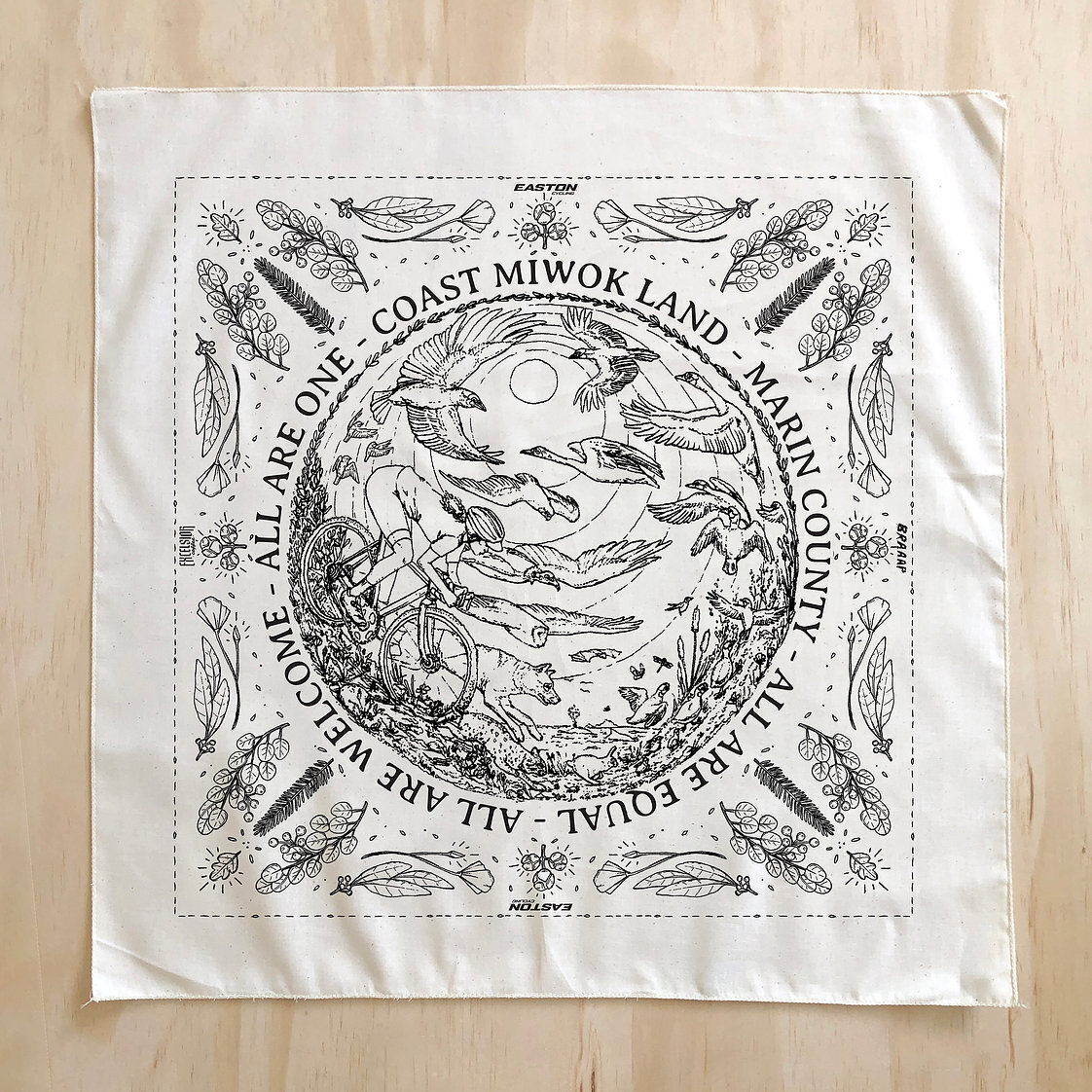
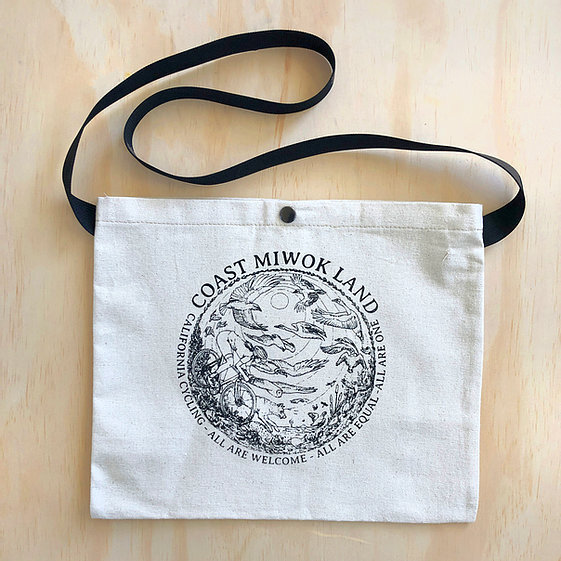
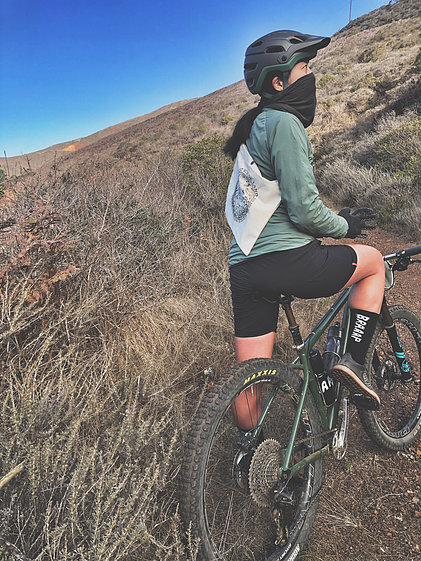
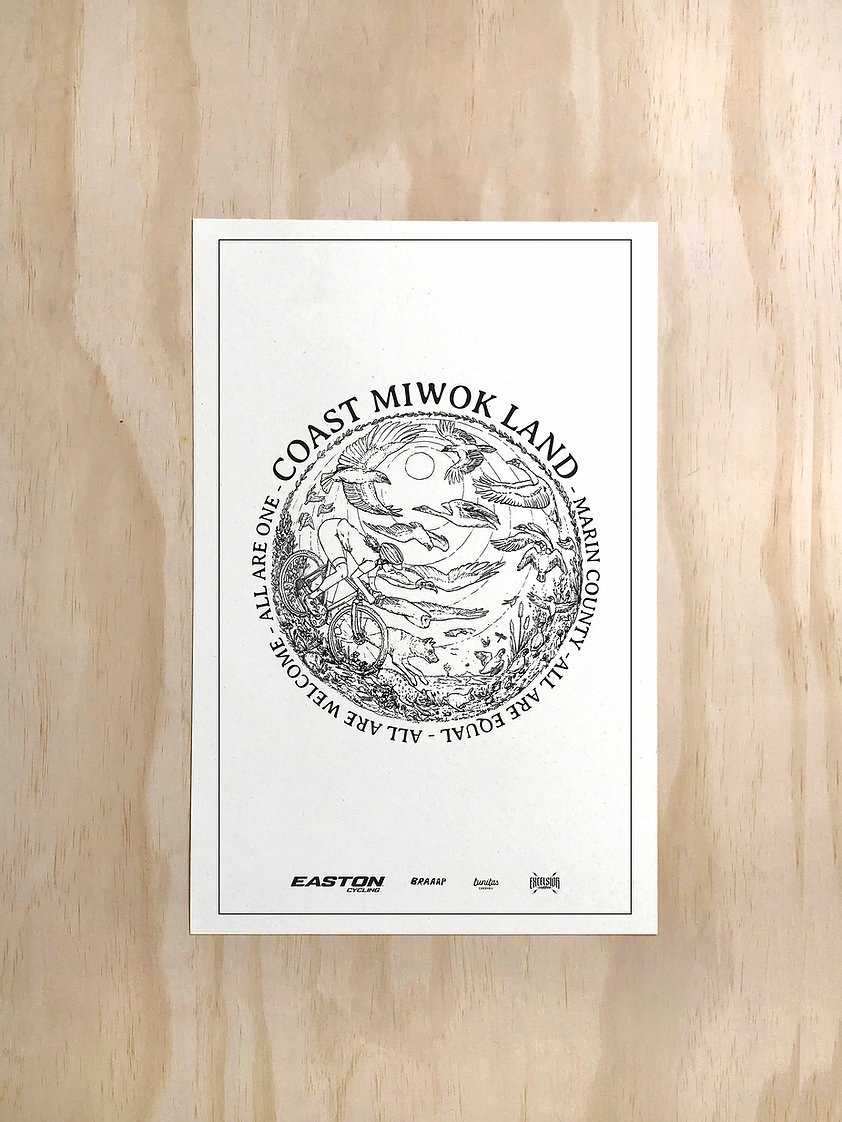
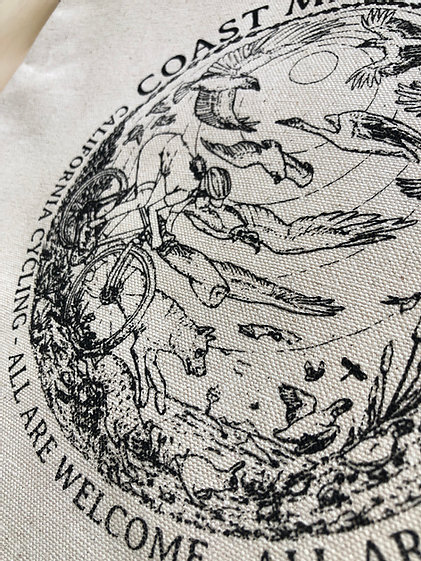
Tell us a little about the illustrations you made for the bandanas, musette bags, and posters. How did you arrive at the concept of things coming full circle and the wreath of California Laurel leaves? What do the symbols represent?
At first the drawing was just my way of expressing the connection I personally felt with nature when I was out riding gravel in Marin. But then there was another aspect I also wanted to capture the mood that the Gravel scene has often been better at than most. Gravel riding is more about enjoying the land and nature you're in and not so much about being super competitive. Cycling tends to feel like a sport where if you aren't being competitive, it somehow feels like you don't belong. How is anyone supposed to belong if we all are competing with each other?!
Often while riding out in Marin I feel extremely lucky to be able to access these lands that were home to so many beautiful creatures. And this overwhelming feeling of needing to find a way to thank the land always popped into my mind while out there. This is where my parent's teachings came in to tell me that I should create artwork that helps give back to the land.
This idea really came through when I made the first iteration of the piece. A ton of folks reached out telling me how it resonated with how they felt about riding gravel. This is when I knew I had something very powerful.
The piece was still missing something, but I couldn't figure out what it was.
That became very clear after I attended a learning session put on by the Coast Miwok at Olompali state park.
Prior to this I had no idea who the first people were in Marin. There really wasn't much to even suggest or acknowledge their existence on these lands. Learning their history really made me... just feel sickened. I myself am part Native, and much of their story resonated with my own and my ancestors background. Having your culture lost and stamped out, and made to feel ashamed of it... I can't even begin to express how painful that is.
To add to this pain, the sport I love and enjoy, and long felt not very welcomed into, was born on lands stolen from these people. To this day this sport is out of reach for many, and enjoyed by those who don't know anything about the Coast Miwok's legacy.
During the learning session we were brought to a large Laurel tree and were taught of the many uses the Coast Miwok had for its leaves.
One use in particular stood out. The Coast Miwok would place the leaves around the perimeter of their dance circle. Doing this helped protect all who entered the circle. Anyone who entered the circle also understood that within the circle there was no hierarchy, and that all were equal and protected.
This lesson was the missing piece in my artwork. This perimeter of Laurel leaves was the final aspect that brought everything full circle. Being that this sport was born on lands who's people lived with this mindset it only makes sense we honor them by learning from their teachings. Cycling needs to be a sport where all are welcome, all are equal, and all are one.
To help the Coast Miwok preserve their history in their own voices, all profits from sales will go towards their gofundme to support their efforts.
A portion of profits will also go to Trips for Kids Marin to help bring the sport to underserved youth.
Photo Credit: Chris Stricklen
Can you tell us a little bit about how the video project with Easton came together?
As I mentioned before storytelling is a huge part of my upbringing. And we as humans are always searching for that feeling of connection and story.
While the artwork itself can certainly tell part of that. I wanted to let people know that there was more to this project than me creating artwork.
I would not be doing this had it not been for every person who has made an impact on my life, and in this case it was my local cycling community. We all have amazing talents and skills, and the people who helped work on this needed to be celebrated in this story. Each of us has a unique gift. And when we come together we can create and support things we care about.
A video would be key in telling this narrative as this is how we consume stories in today's world.
But I had ZERO knowledge in how to make that happen and knew I would need help. So I simply made a post on instagram asking if anyone would be able to just answer questions about making short films for a project aimed to help support diversity in cycling. TONS of folks reached out which was amazing!
Easton knew I was working on the artwork for this project and Immediately asked how they could support me. They truly have been a HUGE support in being there to listen and support the BIPOC community and stepping back to let our voices be heard. I can't thank them enough for this. It's something that can often get tricky when you have a sponsor financially backing a project. But they truly get it !
So while Easton was our sponsor I still had to get someone with know how to actually make the video. Luckily the cycling community is FULL of talented people, and Josh Becker was more than stoked to work on the video. His ability to create what he did based on my brief was truly magical, and it turned out better than I had imagined.
Another VERY important part of this project was working to ensure the Coast Miwok Tribal Council approved the artwork, use of their name, and if they would be willing to accept donations from the project. Getting this done also took some time, and Easton was more than happy to push out launching this project until they had the final sign off.
The folks on the Tribal Council were all superbly kind and grateful that this community wanted to support them and their efforts and were stoked that we wanted to share a lesson from their culture within our community.
Having a brand be open to moving around their calendar to make sure things are done correctly is something I admire and respect Easton for. I honestly can't even begin to thank them enough!
How does your work with Trips for Kids Marin fit into the Full Circle Cycling Land Acknowledgement mission? Is it your hope they can help educate the next generation of cyclists about the history of the land where they ride?
Totally! The main reason for donating to trips for kids really is just to help get them access to all the different ways they can access nature, and to help get them equipment to do so.
You can't just bring kids out there for a day and have these lessons stick. You really need to allow them to find their way of enjoying it. But to do that you need someone to be constantly bringing them out there, teaching them, and giving them literal tools to succeed. We should be striving to empower them to enjoy it and feel comfortable doing so, and Trips for Kids is working to do just that.
I also want to help make cyclists aware of other ways to give back. Ways that could really change someone's ability to enjoy the sport.
Another large aspect of cycling (and the outdoors in general) is that it is EXPENSIVE. Sure you can experience the outdoors with minimal and dated equipment. But part of the barrier also unfortunately lies in the gear and how you are perceived. As a kid it can be embarrassing to have a janky bike, and hand me down shoes and gear. So if you have any nice equipment that you don't use please consider donating it! Seriously you could change someone's world by doing so!
If people want to get involved and learn more about Miwok history – do you have any resources you can share?
Yes!
Covid has unfortunately halted the learning sessions that were being put on. But there are other ways to stay in the loop with the Coast Miwok Tribal Council's efforts and other cool things changing in Marin County.
I have links that I am aware of on my website:
You can also follow this account on Instagram:
If you want to make a trip up to Olompali State Park there are also some places you can visit in that park that share some of their history and landmarks.




